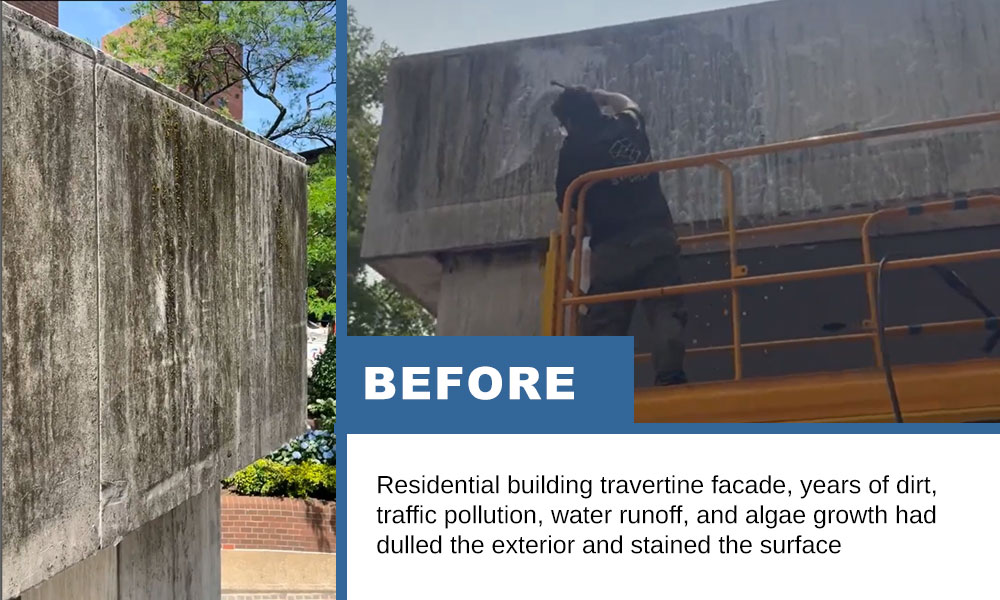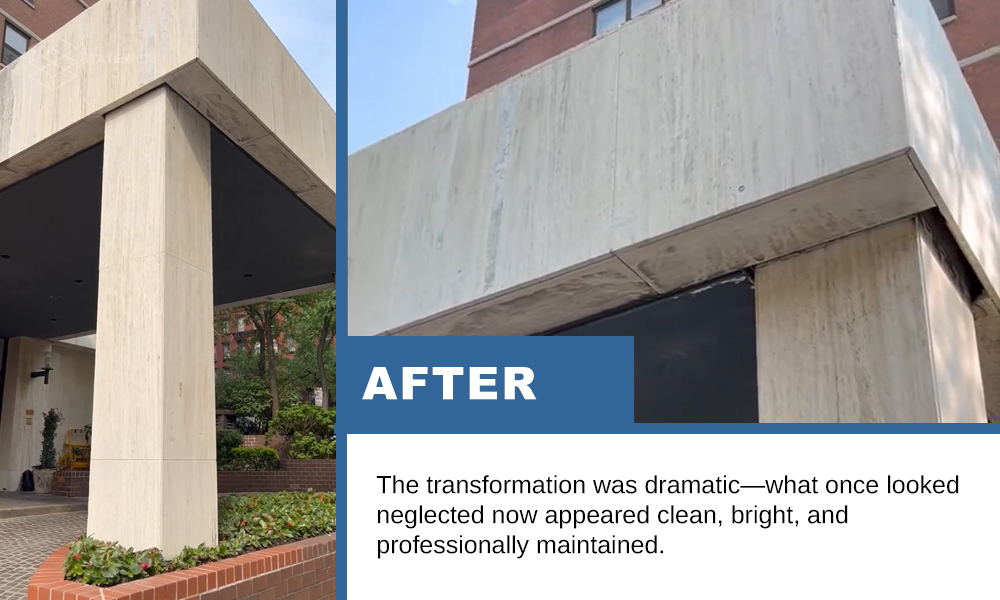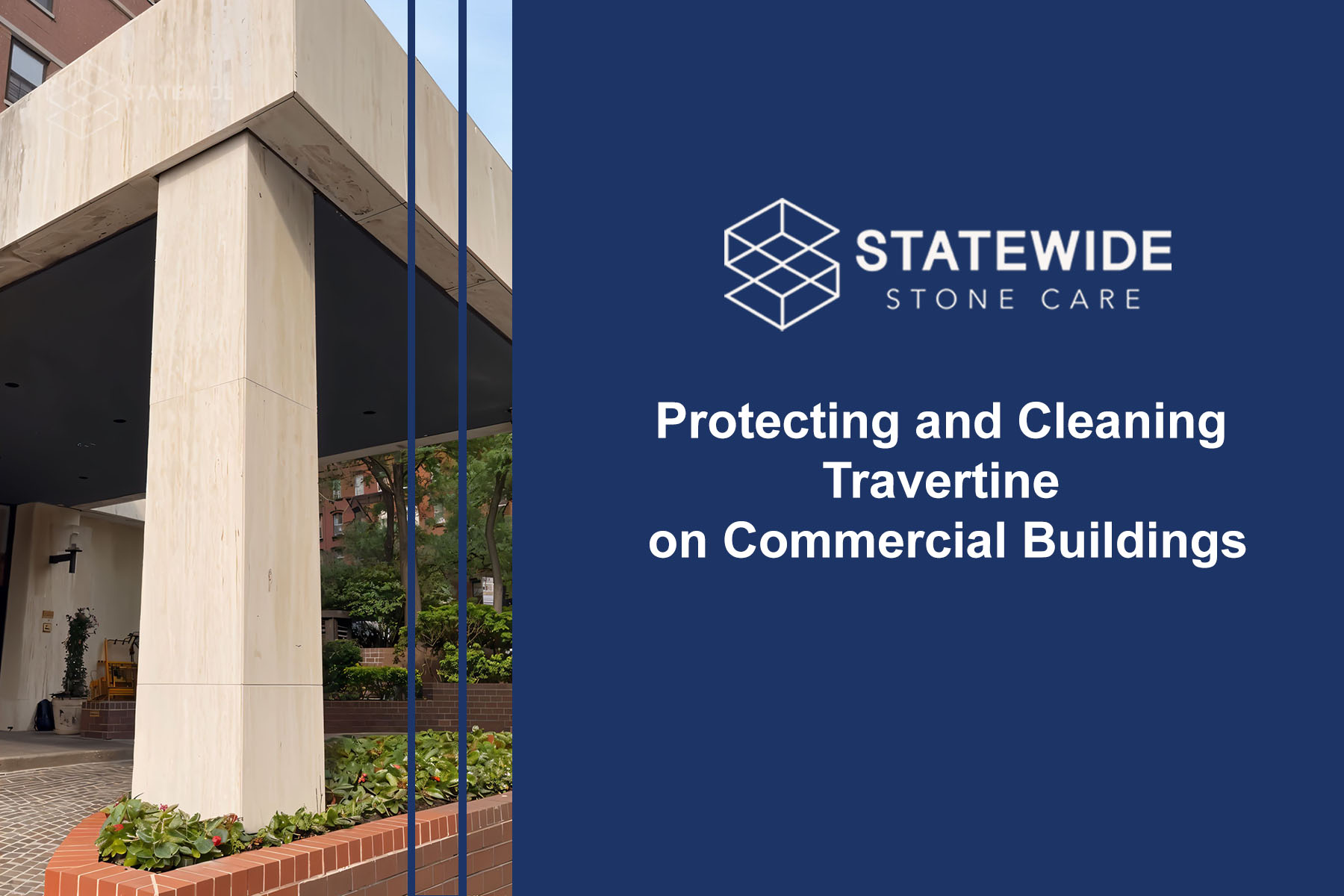Travertine stone is a timeless and elegant choice for commercial building facades, prized for its beauty and durability. However, because it’s a porous material, it is especially vulnerable to collecting dirt, pollutants, mildew and mineral stains—especially when exposed to the elements over time. A neglected stone facade can lose its appeal, develop safety hazards, and suffer a shortened lifespan. Regular professional cleaning not only revives the natural beauty of travertine but also protects your investment—ensuring your building makes a lasting impression with timeless, professional appeal. Discover the challenges of maintaining natural stone exteriors and how to keep them looking pristine all year long.
Understanding Travertine as a Material
Travertine is a limestone is formed by mineral deposits from hot springs or caves and is primarily composed of calcium carbonate. Its natural formation results in distinctive holes and troughs, which are often filled and polished to create a smooth, elegant finish. Available in earthy tones like ivory, beige, gold, and walnut, it brings warmth and classic style to commercial buildings.
This stone is popular for facades because it offers both visual appeal and resilience in a wide range of climates. However, its porous nature allows it to absorb moisture, dirt, and organic matter like mold or algae. These openings can trap grime over time, leading to discoloration and wear if not properly maintained. To preserve its appearance and integrity, gentle cleaning methods and regular sealing are essential.
Common Issues with Dirty Facades
Over time, stone facades naturally begin to show signs of wear due to continuous exposure to the elements. Dirt, dust, and smog can settle into the surface, gradually dulling its natural finish. In humid or shaded areas, mildew and algae may thrive, leaving behind dark streaks or green patches that detract from the building’s overall appearance. Rainwater runoff and hard water often contribute to unsightly streaks, especially in areas where moisture frequently pools or flows.
Efflorescence is another common concern—a white, chalky residue caused by water-soluble salts migrating to the surface. While not structurally harmful, it significantly alters the appearance of the stone and can be difficult to remove without specialized care. Additionally, exposure to acid rain, air pollution, or harsh cleaning agents may result in surface etching and discoloration. These issues not only diminish curb appeal but, if ignored, can lead to long-term deterioration and costly restoration work.
Frequency of Cleaning & Maintenance Plans
Setting a regular cleaning and maintenance schedule is vital to preserving both the look and structure of your facade. While frequency may vary by location, monthly inspections help catch buildup and damage early. A professional deep cleaning is typically recommended once a year, although more frequent cleanings may be needed in high-traffic or polluted areas. Seasonal changes—such as spring pollen, autumn debris, and winter road salts—can also impact the stone and call for targeted cleanings.
Preventive maintenance is more cost-effective than reactive cleaning. Routine care, including light cleaning and timely sealing, prevents dirt buildup and staining, reducing the need for extensive restorations later. Waiting to clean until stains or mold have set can mean longer, more expensive treatments with harsher products. A proactive maintenance plan keeps your facade looking fresh while extending the travertine’s lifespan and lowering overall upkeep costs.
Hiring a Professional Stone Cleaning Company
Bringing in a professional is one of the best ways to care for a stone facade. Natural limestone surfaces require special knowledge and tools to clean safely. Trained technicians can assess the condition, use appropriate stone-safe cleaners, and apply soft washing or pressure control techniques to remove dirt, stains, and organic growth. They also use equipment like aerial lifts and scaffolding to safely access higher or hard-to-reach areas.
Before hiring a contractor, ask important questions: How much experience do they have with natural stone? What methods and equipment do they use? Are they insured and bonded? Can they provide references or photos of past commercial projects? A reputable company should offer a clear plan that includes inspection, cleaning, sealing (if needed), and ongoing care recommendations.


Case Study: Before and After
At a recently restored residential building, years of dirt, traffic pollution, water runoff, and algae growth had dulled the exterior and stained the surface. Our team used a gentle, stone-safe cleaning solution to revitalize the building’s appearance, applying safe and efficient methods that deliver immediate, visible results. The transformation was dramatic—what once looked neglected now appeared clean, bright, and professionally maintained. The refreshed exterior not only improved the building’s curb appeal but also reinforced the client’s confidence in proactive care.
Preserving Travertine in Buildings
Maintaining the natural beauty and longevity of a commercial stone facade requires more than occasional attention—it calls for consistent, well-planned care. This type of surface is highly porous, making it prone to stains, buildup, and organic growth if left untreated. With regular inspections, professional cleanings, and sealing, you can protect both the appearance and value of your building. Don’t wait until signs of wear become damage—contact Statewide Stone Care today for a free consultation or site assessment and let us help restore your property to its best condition.

